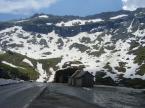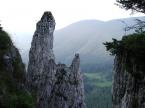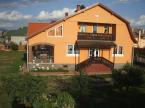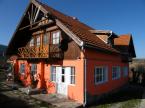Information
Oradea (pronunciation in Romanian:, Hungarian: Nagyvárad, colloquially also Várad, German: Großwardein) is a city located in the county of Bihor, in western Transylvania, Romania. The city proper has a population of 206,614 as of 2002 census; this does not include areas from the metropolitan area, outside the municipality; they bring the total urban area population to approximately 220,000. Oradea is one of the most prosperous cities of Romania.
Geography
The city has a specific geographical situation, it is built in the meeting point of the Crisana plain and the Crisul Repede's basin. It is situated 126 meters high above the sea-level surrounded on the North-Eastern part by the hills of Oradea belonging to the Ses hills. The main part of the settlement is situated on the inundation area and on the terraces situated down the river Crişul Repede. Oradea is famous for its thermal springs. The river Crişul Repede crosses the city right in the centre providing a picturesque beauty to it. Its output depends on the season; the water containers (the dyke near Tilegad) control it in part since they have been made in the early 1980s.<br>
History
Main article: History of OradeaOradea dates back to a small 10th century castle, while its bishopric was founded during the 11th century by King Ladislaus I of Hungary. The first documented mention of its name was in 1113 under the Latin name Varadinum. The Citadel of Oradea, the ruins of which remain today, was first mentioned in 1241 during the Mongol invasion. However, it was not until the 16th century that Oradea started growing as an urban area. In the 18th century, the Viennese engineer Franz Anton Hillebrandt planned the city in Baroque style and, starting from 1752, many landmarks were constructed such as the Roman Catholic Cathedral and the Bishop's Palace, presently the Muzeul Ţării Crişurilor ("The Museum of the Crişland").
After the Ottoman invasion of Hungary in the 16th century, the city was administered at various times by the Principality of Transylvania, the Ottoman Empire, and the Habsburg Monarchy. At the end of World War I, Oradea and Transylvania were united with Romania. During World War II, Northern Transylvania and Oradea were ceded by Romania to Hungary as a result of the Vienna Award; this dictate was reversed at the war's end and the lands were returned to Romania.
After the World War I, governments of Romania engaged in a policy of relocating Romanians to Transyilvania, especially to Southern Transyilvania, the Szekelyland and near the Hungarian-Romanian border.Out of the 82,687 (Oradea's total population in 1930), 13,775 were born abroad and 5,000 were born in Bukovina, Moldavia, Dobrogea, Oltenia. Only 35% of the total population was native resident in 1930.
Ethnic tensions often ran high in the area. Romanian nationalists believe Oradea and the surrounding Bihor region have always been Romanian and were finally restored to Romanian control at the end of World War I. Hungarian nationalists refer to the city's pre-war Magyar majority and previous inclusion in the Kingdom of Hungary. Nowadays, however, Oradea is an example of tolerance and multiculturality, in an authentic European fashion. The different ethnic groups live in harmony, growing on each other's contribution to the modern culture. There are many mixed (Romanian-Hungarian) families in Oradea, with children assimilating both of their parents' languages and cultures as they learn to speak.
Ethnicity
Historical
Contemporary population
Ethnic breakdown from the 2002 census:
- Romanian: 145,284 (70.3%)
- Hungarian: 56,987 (27.6%)
- Roma: 2,449 (1.2%)
- German: 563 (0.3%)
- Slovak: 474 (0.2%)
- Jewish: 166 (0.1%)
- Others: 691 (0.3%)
Quarters
Before 1848, Oradea was made up of 4 separate towns: Várad-Újváros (Villa Nova, former Vicus Zombathely), Várad-Olaszi (Villa Latinorum Varadiensium), Várad-Velence (Vicus Venetia), Várad-Váralja (Civitas Waradiensis). The names Vicus Venetia, Villa Latinorum, Vicus Bolognia, Vicus Padua and others come from French, Walloon, and Italian inhabitants who settled in the 13th century.Today the city is made up of the following districts called quarters (cartiere in Romanian):
- Centru Oradea (city centre); * Nufărul; * Rogerius; * Velenţa; * Ioşia; * Ioşia Nord; * Oncea; * Salca; * Seleuş; * Vie; * Iorga; * Olosig; * Episcopia Bihor
Economy
Oradea has long been one of the more prosperous cities in Romania, due mainly to its location on the Hungarian border, making it the gateway towards Western Europe. After 1989, due to its important base of consumers, Oradea enjoyed economic renewal, not so much in terms of industry but rather in the services sector.Oradea has an unemployment rate of 6.0%, slightly lower than the Romanian average but much higher than Bihor County's average of around 2%. Oradea currently produces around 63% of the industrial production of Bihor County while accounting for around 34.5% of the population of the county. Its main industries are furniture, textiles and clothing, footwear and food.
In September 2002, Metro opened the first "cash & carry" store in Oradea.
In 2003, the Lotus Market commercial centre opened in Oradea, the first large shopping centre to open in the city.
In the spring of 2005, Selgros opened another "cash & carry" store in Oradea.
Transport
- Main article: Transport in Oradea
Oradea is served by Oradea International Airport, which has flights from major Romanian cities and well as some cities in northern Italy.
Education
Oradea is one of the main education centres of Romania. The city is home to the University of Oradea, one of the largest and most modern universities in the country.
Architecture
Oradea's architecture is a mix between Communist-era constructions, mainly in the outer quarters, and beautiful historical buildings, mainly in Baroque style, remnants from the era when the city was part of Austria-Hungary.During Communism and in the first years of Romania's post-Communist transition, many of the historical buildings became derelict or were degrading. After 2002, when Romania entered into a period of economic boom, many historical buildings in the city were restored to their previous state and currently, the city possesses a very historic and well-maintained feel.
Attractions
The beautiful city centre is worth visiting, as are the Băile Felix health spas, accessible by train and located outside the city.Sites worth visiting are:
- Muzeul Ţării Crişurilor - a wonderful Baroque museum with 365 famous windows. It was the Roman Catholic bishop's palace until 1945, when the Communist regime occupied the building. It was returned to the Roman Catholic church in 2003]
- Catedrala barocă - the biggest Baroque cathedral in Romania
- Cetatea Oradea - Oradea's Fortress, with a pentagonal form
- Biserica cu Lună - A unique church in Europe with a type of astronomical clock depicting the phases of the moon
- Pasajul "Vulturul Negru" - The "Black Eagle" Passage
- Muzeul "Ady Endre" - the house of one of the greatest Hungarian poets
- Teatrul de Stat - The State Theatre, whose plans were designed by two Austrian architects who had built around 100 theatres and opera houses in Europe by the end of the 19th century.
- The Main street, officially Str. Republicii, but known to the locals as 'Principala' or 'a Fő Utca' - one of the most beautiful streets of Transylvania, displaying an incredible number of Sezession buildings.
- There are around 100 religious sites of different denominations in Oradea, including three synagogues (however, only one is supposed to be still in use) and the biggest Baptist church in Eastern Europe.
Famous people
- Endre Ady
- Iuliu Baratky
- Ödön Beöthy
- Eliezer Berkovits
- Lajos Biró
- Carl Ditters von Dittersdorf
- Emanoil Gojdu
- Michael Haydn
- Saint Ladislaus I
- Georges Politzer
- Ede Szigligeti
- Julia Varady
External links
- Oradea Cultural and Economical Portal
- Oradea Jurnal Bihorean Site
- Realitatea Bihoreana Site
- Portal Oradean
- Nagyvárad.ro
- Pictures of Oradea

 English
English









